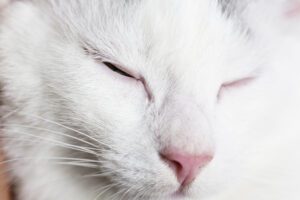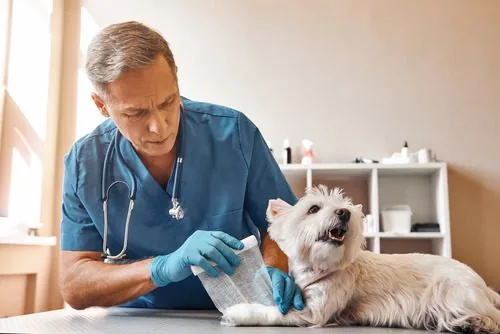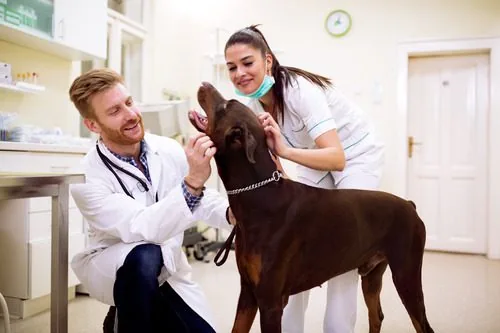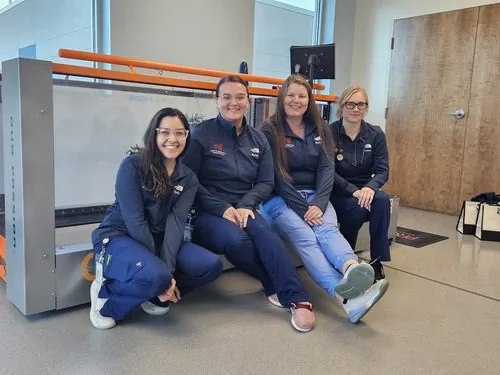Cat Slow Blinking: Why Your Cat Blinks Slowly at You

As a cat owner, you may have noticed your feline companion engaging in a peculiar behavior: slow blinking. This slow, deliberate closing and opening of their eyes can be quite endearing, but it may leave you wondering what it means.
Cats slow blink at you to express that they trust you. A feline slow blinking means that they are happy and feel loved.
In this article, we’ll explore the reasons behind cat slow blinking and what it signifies about your relationship with your pet.
Understanding Cat Slow Blinking
Cats communicate with each other and their human companions in various ways, including body language, vocalizations, and facial expressions. Slow blinking is one of the many subtle ways cats convey their feelings and intentions.
When a cat slow blinks at you, they are often expressing a sense of trust, contentment, and affection. In the feline world, closing their eyes in the presence of another creature makes them vulnerable, as they are unable to detect potential threats. By slow blinking at you, your cat is demonstrating their trust in you and signaling that they feel safe and relaxed in your company.
How to Respond to Your Cat’s Slow Blink
When your cat slow blinks at you, it’s an excellent opportunity to strengthen your bond with them. Here are a few ways to respond to their slow blink:
Slow Blink Back
Try mirroring your cat’s slow blink by gently closing and opening your eyes in a relaxed manner. This can help to reinforce your bond and create a sense of mutual trust and affection.
Speak Softly
Use a gentle, soothing tone when talking to your cat as they slow blink. This can help to create a calming atmosphere and further reinforce the positive emotions associated with the slow blink.
Offer Affection
If your cat is comfortable with physical touch, consider offering them a gentle head scratch or chin rub while they slow blink at you. This can help to strengthen your bond and provide positive reinforcement for their trusting behavior.
Observe and Respect Their Boundaries
It’s essential to pay attention to your cat’s body language and respect their boundaries. If your cat slow blinks but also displays signs of agitation or discomfort, such as a twitching tail or flattened ears, it’s crucial to give them space and avoid overwhelming them.
Benefits of Cat Slow Blinking
There are several benefits to understanding and responding to your cat’s slow blinking. Some include:
Enhanced Bond
Recognizing and reciprocating your cat’s slow blink can help to strengthen the bond between you and your pet, leading to a more trusting and affectionate relationship.
Improved Communication
Understanding your cat’s slow blink as a form of communication can help you to better interpret their emotions and needs, allowing you to respond more effectively and compassionately.
Reduced Stress
Cats often slow blink when they are relaxed and content. Encouraging and engaging in slow blinking with your cat can help to create a calming environment and reduce stress levels for both you and your pet.
Understanding Your Cat’s Personality
Observing your cat’s slow blinking and other body language cues can provide valuable insights into their unique personality and preferences, allowing you to better understand and care for your feline companion.
Understanding Cat Socialization
To fully appreciate the significance of the slow blink, it’s essential to understand the basics of cat socialization. Unlike dogs, which are pack animals and have a more straightforward social structure, cats are more independent creatures that form complex social hierarchies. This means that trust and affection are earned rather than given freely, making the slow blink a valuable indicator of your cat’s feelings towards you.
Building Trust with Your Cat
Building trust with your cat is vital to fostering a strong bond and encouraging slow blinking behavior. Some strategies to establish trust with your cat include:
- Providing a consistent and predictable routine: Cats thrive on routine and predictability, so maintaining a consistent schedule for feeding, playtime, and other daily activities can help to create a sense of security and trust.
- Giving your cat space: It’s essential to respect your cat’s personal space and allow them to approach you on their terms. Avoid forcing interactions and be patient as your cat becomes more comfortable in your presence.
- Positive reinforcement: Encourage positive behaviors, such as slow blinking or approaching you, with gentle praise, treats, or affection, as appropriate for your cat’s preferences.
- Creating a safe and enriching environment: Provide your cat with a secure, comfortable, and stimulating living space, including cozy hiding spots, scratching posts, and toys to explore and interact with.
The Science Behind Slow Blinking
Research has shown that slow blinking is not just an anecdotal behavior observed by cat owners but a scientifically supported form of communication. A study conducted by the University of Sussex in the United Kingdom found that cats are more likely to slow blink at their owners when their owners slow blink at them. Furthermore, cats were more likely to approach an experimenter who had slowly blinked at them compared to an experimenter who maintained a neutral expression.
These findings support the idea that slow blinking serves as a form of positive emotional communication between cats and humans, helping to build trust and strengthen the bond between the two species.
Encouraging Slow Blinking in Multi-Cat Households
If you have multiple cats in your household, you may observe slow blinking behavior between your feline companions as a sign of trust and friendship. Encouraging positive social interactions and slow blinking between your cats can help to maintain a harmonious household.
This can be achieved by introducing new cats gradually, providing your cats with plenty of food, water, litter boxes, toys, and space, and engaging in group play and bonding activities.
Conclusion
Cat slow blinking is a fascinating and endearing form of communication that can help to strengthen the bond between you and your pet. By understanding the meaning behind this behavior and learning how to respond appropriately, you can foster a trusting and affectionate relationship with your cat. Remember to always respect your cat’s boundaries and pay close attention to their body language to ensure a positive and nurturing interaction.
Are you looking for a veterinarian for your pet? Veterinary Healthcare Associates in Winter Haven, FL is here to help. Give us a call at (863) 324-3340 today!
Recent Posts
Working at a 24/7 Emergency Veterinary Practice
Working at a 24/7 Emergency Veterinary Practice Working at a 24/7 emergency veterinary practice is a unique…
Do Veterinarians Have a Good Work-Life Balance?
Do Veterinarians Have a Good Work-Life Balance? When it comes to the dedicated professionals who care for…
6 Reasons to Work in a Specialty Referral Veterinary Practice
6 Reasons to Work in a Specialty Referral Veterinary Practice Working in the veterinary field is incredibly…
Is Being an Oncology Veterinarian a Rewarding Career?
Is Being an Oncology Veterinarian a Rewarding Career? Choosing a career path in veterinary medicine opens the…
Canine Water Treadmill Therapy
Canine Water Treadmill Therapy Welcome to our informative guide on Canine Water Treadmill Therapy. This revolutionary rehabilitation…
About Veterinary Healthcare Associates
Veterinary Healthcare Associates in Winter Haven, FL, was established over 30 years ago as Maxwell Animal Clinic by Dr. John Maxwell. Maxwell Animal Clinic was a one-doctor general practice offering preventive care, dentistry, and standard surgical services to the community. As the years passed, Maxwell Animal Clinic evolved into a thriving 10-doctor general, specialty referral, and emergency veterinary practice.








